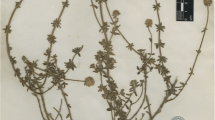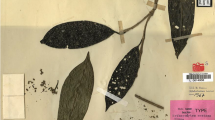Abstract
Recommendations on the proper typification of names published in Vellozo’s Florae Fluminensis are provided, using as examples the friar’s published names for taxa of Eriocaulaceae, Polygalaceae and Violaceae, which were based on specimens that likely originated in the municipality of Cunha, in the Brazilian state of São Paulo. We designate as lectotypes illustrations from the unpublished iconography of Florae Fluminensis, preserved at the Biblioteca Nacional in Rio de Janeiro for the previously untypified names Polygala bonavisio, P. quinqueangularis, P. multicaulis, P. glandulosa, Viola diffusa and V. exigua. We also illuminate parallel illustrations from an incomplete copy of the iconography housed at the Torre do Tombo (Lisbon) but conclude that the materials in Biblioteca Nacional are in general more accurate in their depictions, and thus preferred as lectotypes. When needed, epitypes are chosen from specimens collected in the region of Vellozo’s likely type localities in order to assist proper application of his names. Besides typifications, taxonomic notes on Vellozo’s taxa and photographs of them in the field are provided.







Similar content being viewed by others
Literature cited
Bennett, A. W. 1874. Polygalaceae. Pp. 1–82. In: C. F. P. Martius, A. W. Eichler & I. Urban (eds.), Flora Brasiliensis, vol 13, part 3. Frid. Fleischer, Leipzig.
Bocage, J. V. B. 1862. Ilustrações práticas sobre o modo de coligir, preparar e remeter produtos zoológicos para o Museu de Lisboa. Imprensa Nacional, Lisboa. (https://doi.org/10.5962/bhl.title.63908).
Buzzato, C. R., R. B. Singer, G. A. Romero-Gonzàles, C. van den Berg & G. A. Salazar. 2013. Typifications and taxonomic notes in species of Brazilian Goodyerinae and Spiranthinae (Orchidaceae) described by José Vellozo and Barbosa Rodrigues. Taxon 62: 609–621. https://doi.org/10.12705/623.10.
Carauta, J. P. P. 1973. The text of Vellozo’s Flora Fluminensis and its effective date of publication. Taxon 22: 281–284. https://doi.org/10.2307/1218138.
Cervi, A. C. & W. A. Rodrigues. 2010. Nomenclatural and taxonomic review of Passifloraceae species illustrated and described by Vellozo in Flora Fluminensis. Acta Botanica Brasilica 24: 1109–1111. https://doi.org/10.1590/S0102-33062010000400029.
Chagas, E. C. O., M. Trovó, D. C. Zappi, J. Prado & A. M. Giulietti. 2018. Unravelling Vellozo’s Dupatya (Eriocaulaceae): A long-standing case of mistaken identities and species. Taxon 67: 586–590. https://doi.org/10.12705/673.9.
Chagas, E. C. O. 2017. Sistemática de Eriocaulon L. (Eriocaulaceae) do Brasil. Unpublished Ph.D. thesis, 635 pp. Universidade Estadual de Feira de Santana, Feira de Santana.
Gentry, A. H. 1975. Identification of Vellozo's Bignoniaceae. Taxon 24: 337–344. https://doi.org/10.2307/1218342.
Hamy, E. T. 1908. La Mission d’Etienne Geoffroy Saint-Hilaire en Espagne et en Portugal (1808). Histoire et documents. Masson, Paris.
Knapp, S., G. E. Barboza, M. V. Romero, M. Vignoli-Silva, L. L. Giacomin & J. R. Stehmann. 2015. Identification and lectotypification of the Solanaceae from Vellozo’s Flora Fluminensis. Taxon 64: 822–836. https://doi.org/10.12705/644.14.
Kessous, I. M., F. Salgueiro & A. F. Costa. 2018. Nomenclature and epitypification of Vriesea (Bromeliaceae) species described in Vellozo’s Flora fluminensis. Phytotaxa 350: 24–32. https://doi.org/10.11646/phytotaxa.350.1.3.
Kunze, G. 1837. Zur Erläuterung der in Arrabida's Flora Fluminensis dargestellten Kryptogamen. Flora 20: 321–326.
Lima, H. C. de 1995. Leguminosas da Flora Fluminensis - J. M. da C. Vellozo: lista atualizada das espécies arbóreas. Acta Botanica Brasilica 9: 123–146. https://doi.org/10.1590/s0102-33061995000100006.
Loeuille, B. & J. R. Pirani. 2016. Two new syncephalous species of Eremanthus (Asteraceae: Vernonieae) from southeastern Brazil. Phytotaxa 243: 128–136. https://doi.org/10.11646/phytotaxa.243.2.2.
Moraes, P. L. R. de 2018. Notes on the identities of new genera and species published by Domenico (Domingos) Vandelli in the Florae Lusitanicae et Brasiliensis specimen. Feddes Repertorium 130: 19–64. https://doi.org/10.1002/fedr.201800009.
Pastore, J. F. B. 2013. A review of Vellozo’s names for Polygalaceae in his Flora Fluminensis. Phytotaxa 108: 41–48. https://doi.org/10.11646/phytotaxa.108.1.2.
Pastore, J. F. B., M. Mota, H. F. de Menezes & M. Trovó. 2021. Vellozo’s Floræ Fluminensis: a new assessment of the São Paulo part of the collecting itinerary, its vegetation, and species list. Taxon 70: 1078–1095. https://doi.org/10.1002/tax.12509.
Pellegrini, M. O. O., R. C. Forzza & C. M. Sakuragui. 2015. A nomenclatural and taxonomic review of Tradescantia (Commelinaceae) species described in Vellozo's Flora fluminensis with notes on Brazilian Tradescantia. Taxon 64: 151–155. https://doi.org/10.12705/641.3.
Pellegrini, M. O. O. & M. L. S. Carvalho. 2016. The identity and application of Coletia madida Vell. and notes on the typification of Mayacaceae. Taxon 65: 605–609. https://doi.org/10.12705/653.12.
Ricardo, L. M., B. M. Dias, F. L. B. Mügge, V. V. Leite & M. G. L. Brandão. 2018. Evidence of traditionality of Brazilian medicinal plants: The case studies of Stryphnodendron adstringens (Mart.) Coville (barbatimão) barks and Copaifera spp. (copaíba) oleoresin in wound healing. Journal of Ethnopharmacology 219: 319–336. https://doi.org/10.1016/j.jep.2018.02.042.
Thiers, B. (2022, continuously updated). Index herbariorum: a global directory of public herbaria and associated staff. New York Garden's Virtual Herbarium. http://sweetgum.nybg.org/science/ih/ (Accessed: 8 January 2022).
Tropicos. 2022. Tropicos.org. Missouri Botanical Garden. https://tropicos.org/name/26615767 (Accessed: 25 Jan 2022).
Turland, N. J., J. H. Wiersema, F. R. Barrie, W. Greuter, D. L. Hawksworth, P. S. Herendeen, S. Knapp, W.-H. Kusber, D.-Z. Li, K. Marhold, T. W. May, J. McNeill, A. M. Monro, J. Prado, M. J. Price & G. F. Smith (eds.). 2018. International Code of Nomenclature for algae, fungi, and plants (Shenzhen Code) adopted by the Nineteenth International Botanical Congress Shenzhen, China, July 2017. Regnum Vegetabile 159. Koeltz Botanical Books, Glashtten, Germany. https://doi.org/10.12705/Code.2018.
Vellozo, J. M. da C. 1829 (“1825”). Florae Fluminensis. ex Typographia Nationali, Flumine Januario [Rio de Janeiro]. (https://doi.org/10.5962/bhl.title.745).
Vellozo, J. M. da C. 1831 (“1827”). Florae Fluminensis icones, 11 vols. ex off. lithogr. Senefelder., Parisiis [Paris]. (https://doi.org/10.5962/bhl.title.70380).
Vellozo, J. M. da C. 1881. Florae Fluminensis. Arquivos do Museu Nacional do Rio de Janeiro 5. apud Machado & C., Flumine Januario [Rio de Janeiro]. https://doi.org/10.5962/bhl.title.463.
Acknowledgements
We thank Scott Heald for revising the English language. JFBP is grateful to the Conselho Nacional de Desenvolvimento Científico e Tecnológico (CNPq) for their financial support (grant# 302972/2020-0). GMA thanks CAPES, the American Society of Plant Taxonomists, and Idea Wild for their financial support.
Funding
This work was supported by Conselho Nacional de Desenvolvimento Científico e Tecnológico (CNPq) (grant# 302972/2020–0) given to JFBP; and Coordenação de Aperfeiçoamento de Pessoal de Nível Superior - Brasil (CAPES) - Finance Code 001, the American Society of Plant Taxonomists, and Idea Wild given to GMA.
Author information
Authors and Affiliations
Corresponding author
Ethics declarations
Competing Interests
All authors certify that they have no affiliations with or involvement in any organization or entity with any financial interests or other competing interests in the subject matter or materials discussed in this manuscript.
Rights and permissions
Springer Nature or its licensor holds exclusive rights to this article under a publishing agreement with the author(s) or other rightsholder(s); author self-archiving of the accepted manuscript version of this article is solely governed by the terms of such publishing agreement and applicable law.
About this article
Cite this article
Pastore, J.F.B., Trovó, M., Mota, M. et al. Recommendations for typification of Vellozo’s names from Cunha, São Paulo (Brazil): Eriocaulaceae, Polygalaceae, and Violaceae. Brittonia 74, 321–332 (2022). https://doi.org/10.1007/s12228-022-09726-8
Received:
Revised:
Accepted:
Published:
Issue Date:
DOI: https://doi.org/10.1007/s12228-022-09726-8




